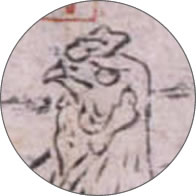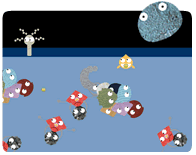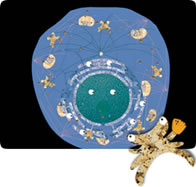A laughing, tumbling frog…a rabbit bounding around on its hind legs…the Scroll of Frolicking Animals (Choju giga), painted in ink with a light brushwork, is a painting of unparalleled appeal in its dynamism of anthropomorphized animals. The famous first scroll features such attractive animals as monkeys, foxes, cats, and owls, whose activities begin with frolicking in the water and continue with archery and sumo, playing musical instruments, and conducting a Buddhist service. In continuation, the second scroll is of a different nature, resembling an ecological field guide for animals or picture book. It depicts such familiar animals as cows, horses, and hawks, as well as such unusual or fictional bests as tigers and dragons.
A closer look reveals a richness of expression in the animals of the second scroll, however. While the animals of the first scroll walk about on two legs, wear clothes, and purport themselves as humans, the animals of the second scroll seem to have a human spirit despite their conduct as animals. This gives them a greater familiarity than the anthropomorphized animals of the first scroll. Neither a satire of human society nor a fairy tale, the scrolls reveal the heart of an artist that sees both animals and humans as living creatures inhabiting the same world.
Take a look at the eyes of the animals in the second scroll. These eyes are characteristic of humans, with large whites. Humans know the object of the line of sight by the position of the other person’s pupils, and emotions can be discerned by the shape of the entire eye. Providing the same line of sight to animals through brush strokes gives them the eyes of humans, and these eyes speak more eloquently than the mouth. |
 |
Scroll of Frolicking Animals (Choju giga) (Second scroll)
Latter part of the Heian Era / The Kozanji Temple collection (Photo: Kyoto National Museum) As can be seen from the fighting dogs, the hen and the chick, and the roosters battling over turf, the animalsí movements are accurately depicted, and they are given facial expressions. These are indeed animals as seen from the human perspective.
Tsukumogami Scroll (First scroll)
Edo period / Copy / In the collection of the Kyoto University Library
http://edb.kulib.kyoto-u.ac.jp/
exhibit-e/otogi/tsukumo/
tsukumo.html
Legend has it that 100 years after a utensil is made, a spirit dwells within it, which is the origin of the term Tsukumogami. Old tools were thrown away on the road because they led people astray. They plotted revenge on humans, caused evil deeds to occur, and finally returned to Buddhism and enter Nirvana. |
††† |



